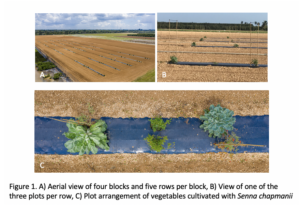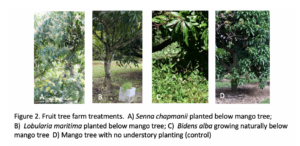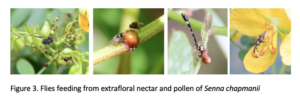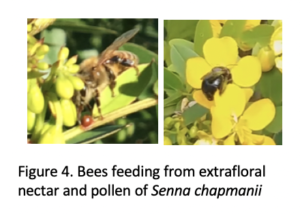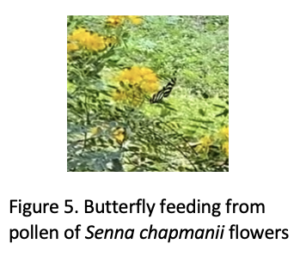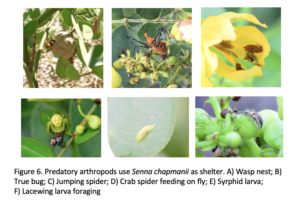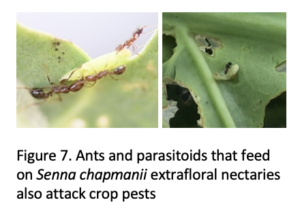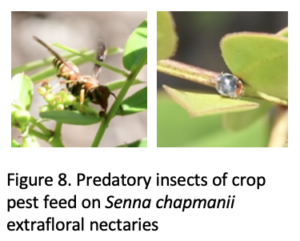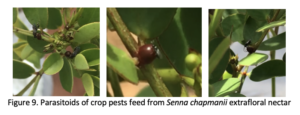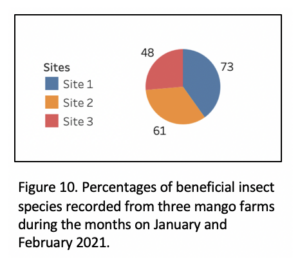Final report for GS17-170
Project Information
Crops cultivated in isolation from other plants usually need supplemental measures to combat pests and to provide pollination. We wanted to find out if the use of insectary plants of different types (native vs. non-native) could enhance the diversity and abundance of beneficial insects in the vicinity of the crop plants. Our goal was to test the potential of the native perennial legume of pine rocklands in south Florida, Senna chapmanii, as an insectary plant in the cultivation of both vegetable crops and fruit trees.
Field experiments were conducted growing two vegetable crops (tomato and collards) with and without the companion plants in an experimental array. A different design was used for fruit trees already established in orchards, placing potential beneficial plants beneath certain trees, and not beneath others. In both experiments, insects were monitored on the crops as well as on the companion plants to determine how many and what types of insects were present.
Our preliminary inspection of the data suggest that Senna chapmanii grow well and serve as good insectary plants, equal to if not better than the non-native insectary plants frequently used in sustainable agriculture. These plants provide extrafloral nectar throughout the year to attract a wide array of arthropods, many of which are pollinators, predator,s and parasitoids. Their bright yellow flowers also attract pollen-collecting bees and other insects that may be more likely to pollinate the crops.
Project Objectives:
Our project addresses the introduction of native plants as an alternative to bolster beneficial insect populations in agroecosystems. We hope to show that native perennial plants can provide resources for beneficial insects to enhance biotic pollination and natural pest control in agroecosystems.
Enhancing the food web structure through increased diversity and establishment of beneficial insects should enable crops to allocate their energy on fruit and vegetable yield, reducing chemical input, thus affecting associated cost of production. Because natural areas overlap with agricultural areas in south Florida, this project encourages conservation outside protected areas by integrating native threatened species to agricultural systems.
Cooperators
- (Researcher)
- (Educator)
- (Educator)
- (Educator)
Research
In this study, we cultivated Senna mexicana var. chapmanii to investigate how resources offered by this native plant affect insect-mediated ecosystem services in agroecosystems. Senna mexicana (Jacq.) H.S.Irwin & Barneby var. chapmanii (Isely) H.S.Irwin & Barneby (henceforth referred to as Senna chapmanii) is native to southern Florida and is currently listed as threatened, occurring only in Miami-Dade and Monroe counties, as well as in the Bahamas and Cuba. Extrafloral nectaries (EFNs) of Senna chapmanii occur on the pedicels of their buzz pollinated yellow flowers and throughout the foliage between basal leaflets. This woody perennial grows naturally as an upright or sprawling subshrub in the Pine rockland and Rockland hammock ecosystems and is valued as an ornamental because it is drought tolerant, adapted to local climate, and requires little maintenance. Vegetables (cherry tomato, collard greens) and non-crop plants (Senna chapmanii, Lobularia maritima) were grown from seed in a greenhouse (2017-2018) and transplanted to the research sites (2018-2019) while Bidens alba and mango trees were already established in farms. The vegetable plots were established using a randomized complete block design with four blocks with a buffer of 20 m to account for variability in soil, moisture, sunlight, and irrigation direction at the field site (Fig 1A). Each of the five rows per block contained three plots. Plots were spaced 11 m from each other (Fig. 1B). Treatments were randomly assigned to each of the three plots in a row with crops cultivated i) with native (S. chapmanii), ii) with non-native (L. maritima), iii) without any secondary plant, transplanted as strips of vegetation between two strips of crops (Fig. 1C). No pesticides were applied to treatments in the vegetable site. Sites were monitored weekly before, during and after flowering and fruiting.
The mango project has just been completed at two commercial farms and at The Williams Grove at the Farm of Fairchild Tropical Garden. Each site differed in the type of management. For one of the commercial farms, and the Fairchild Farm, we used a randomized block design in which three treatments were randomly assigned to each of the 30 plots with crops cultivated i) with S. chapmanii ii) with L. maritima or with B. alba, iii) only crops/without non-crop plants. Each non-crop plant was grown inside column blocks placed one foot away from each tree. The other commercial site had only crops, and pesticides were applied periodically. Sites were monitored weekly before, during and after flowering and fruiting (Fig. 2).
Data collection culminated this year. The following results shown for this study are preliminary.
Floral visitors: Flower visitors of crops such as flies (Fig. 3), bees (Fig. 4), and butterflies (Fig 5) used S. chapmanii for nutrition (pollen, extrafloral nectar) and shelter, while L. maritima and B. alba are used for pollen and nectar. Senna chapmanii and L. maritima did not compete with the crops for pollinators, while B. alba flowers were visited more than the crops’ flowers. Yield data cannot be linked solely to plant-arthropod interactions, as other factors can affect fruits. Fruits may be consumed pre-harvest by rodents and birds. Furthermore, unfavorable environmental conditions can cause fruits to drop down in the ground.
Natural enemies and pests: Adult and immature stages of predatory arthropods found on crop plants (such as syrphid flies, lacewings, beetles, true bugs, wasps, and spiders) feed from alternative prey such as aphids and caterpillars encountered in non-crop plants and use S. chapmanii, L. maritima, and B. alba for shelter (Fig. 6) and pollen, nectar, and extrafloral nectar (Fig. 7). Ants and parasitoids used S. chapmanii for extrafloral nectar, pollen, and shelter and also used L. maritima and B. alba for pollen and nectar. Caterpillar herbivores of collards and tomato were attacked by ants and parasitoids (Fig. 8). Scale insects were not attacked by predators or parasitoids whenever ants fed on their secreted honeydew. Certain generalist caterpillars that feed from crops also fed from L. maritima and B. alba plants. Parasitoids that attack crop pests also feed on extrafloral nectar, nectar, and pollen of the studies non-crop plants (Fig. 9).
Abundance and diversity of beneficial insects and pests: We expect to find greater abundance and diversity of beneficial insects interacting with crops in sites where there is occasional or no synthetic pesticide applied and where companion plants do not compete for pollinators. This may also be correlated with lower damage to the crop plants, and higher rates of predation and parasitization of pest insects. As some farmers maintain a regime of pesticide application, we anticipate lower abundance and diversity of pests for crops where more types of synthetic chemicals are applied and crops are not growing with companion plants versus unsprayed areas. Percentages shown below belong to the first and second month of Mango flowering of this year (2021). For this year, there is a lower percentage of beneficial insects interacting with crops in sites where crops are cultivated without non-crop plants (Fig. 10).
Educational & Outreach Activities
Participation Summary:
Participation/Education/outreach description:
During the planning phase of the project in 2017-2018, we visited 13 farmers (names of farms not published here as we did not get permission to do so) to present the proposed practice of introducing native plants in farms and gather ideas to set-up during the planning phase of this project according to the needs of the crop produced. Presentations were made in person, using visuals on a laptop computer, and all were received graciously by the farmers. We applied for and received FIU-IRB approval for the questionnaires and interviews planned for this project. The final interviews have not yet been conducted.
The actual experiments took place on only three farms, involving two farmers and the Fairchild Garden director of grounds. We will interview them when results are completed to determine their final attitudes toward alternative methods in crop cultivation in south Florida.
Presentations about this research project were given by Andrea Salas Primoli at the Pine rockland working group and ICTB meeting (October, 2018), Botanical Society of America (July 2018), Florida Native Plant Society (May 2018), and North American Butterfly Association (August 2017). We plan to publish results in peer-reviewed journals and disseminate results in technical articles for growers within one year.
Educational and Outreach activities
3 Talks/Presentations
Project Outcomes
Our project will provide alternative management of detrimental and beneficial arthropods through enhancement of habitat and nutritional sources produced by indigenous vegetation. Besides promoting biodiversity and conservation of native populations, the benefits of introduction of non-crop plants in monocrop agroecosystems can provide safe habitats and resources for arthropods that can benefit the crops. Such changes will be beneficial for the environment by reducing chemical input leading to cleaner water and air. They may also provide economic benefits to growers, farm workers, and society by supporting ecosystem services.
Given an increase in beneficial insects, we hope that growers will cultivate S. chapmanii and farmers will use it. Perhaps they will also consider more native plants as allies for sustainable production of crops. By augmenting their fields with this and other native species that can provide alternative rewards for arthropods when the crops are not in bloom, some of the native beneficial fauna will be restored to an otherwise depauperate landscape.
Abiotic factors such as temperature, wind, and rain and other non-arthropod populations (such as avian, rodents, and soil microorganisms) can greatly influence yield of crop plants. All these and others can cause fluctuations in the populations of insect pollinators, natural enemies, and pests. Effects on flowering time and fruiting duration will also have implications for the importance of maintaining beneficial insects before and after flowering of the crop plants. We acknowledge that the impact of native and other insectary plants on yield of crop plants cannot be attributed only to insect-mediated ecosystem services. However, the far-reaching benefits to the environment of sustainable agricultural practices will impact more than just crop yield, but lead to a more balanced, cleaner, and healthier environment for the people of south Florida.
Final statement
We gratefully acknowledge the importance of the SARE grant in the support of this research. We will do so in all publications and the dissertation to be completed this year. We will provide copies of that and all publications in the coming years.
We learned a great deal not only from conducting the research, but by attending SARE webinars to hear about initiatives around the country. It has been very exciting to be a part of this program.
